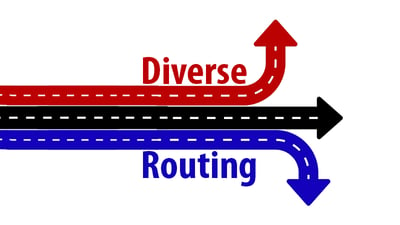Session Initiation Protocol (SIP) is a protocol used to create and terminate real-time sessions between two or more parties over an IP network. SIP sessions can involve the transmission of multimedia including video, voice, or other communications but are often used to deliver phone calls over the internet, commonly referred to as Voice over IP (VoIP).
*It should be noted that SIP and VoIP are NOT the same thing - Session Initiation Protocol is the protocol that facilitates Voice over IP.
A SIP trunk can be a great voice solution for your organization, serving as your main connection or as a backup. It is cheap, flexible, and easy to manage.
SIP Trunking Pros
- Quick Installation
The infrastructure required for session initiation protocol is virtual rather than physical, meaning you can be assigned and delivered a virtual connection over your existing ISP or carrier connection. Rather than waiting weeks or months your order can be completed within hours or days of your request.
- SIP Trunk Pricing is Cost Effective
SIP trunking requires much less of a financial investment because physical infrastructure doesn’t have to be purchased and installed. One caveat to this would be a business that plans to scale up the number of phone lines in use. SIP is cost effective for small scale operations, however, you are charged per phone line with SIP whereas with PRI you receive 23 phone lines. At some point the cost savings on infrastructure from SIP will be outweighed by the cost of additional phone lines.
SIP Trunking Cons
- Failure Points Are Beyond Your Control
Because session initiation protocol is delivered over the internet, you’re fully reliant on your internet service provider or carrier to maintain and keep up their network. If you’re ISP or carrier goes down, your SIP will be down too.
- Calls Aren’t Prioritized
Depending on the SIP trunk provider, outbound calls aren’t prioritized. If this is the case with the provider you choose, your calls are treated like any other piece of data including webpages and emails. This may result in lower or inconsistent call quality depending on your available bandwidth and data usage.
[Read More: Eliminate Downtime with Diverse Routing - Utilizing PRI & SIP]
SIP Trunking is good for you if…
As a main connection, SIP trunking is a good solution for you if you live in an area with competitive ISP’s who can deliver you low latency, low jitter services. The cost savings from forgoing the purchase and installation of physical infrastructure required by other solutions, like primary rate interface (PRI) make SIP a good solution for smaller businesses who need multiple phone lines.
If your business relies on your phone system to be operational at all times, SIP is a great solution to consider adding to your business continuity plan. As a backup, SIP is actually more flexible than PRI because SIP can automatically switch to a backup internet pipeline in the event that your primary connection goes down. The rigidity of PRI won't allow for this feature. Diverse routing is one of the best ways to ensure that your phones stay on when something goes awry.
What to look for in a SIP Trunking provider…
If you think SIP is the solution for you there are a few things you should consider before deciding on a SIP provider. Not all solutions are the same so it is important to seek a SIP provider that can meet your needs. Look for a SIP provider offering
- Redundancy
SIP is reliant on the internet service provider to keep their network up. If things go haywire at the providers location, can they ensure that you’ll still be able to make calls?
- Scalability
You want a SIP provider who can grow with your business. A SIP provider may be able to meet your needs today, but what about five years from now?
- SLA's Reliability
Service-level-agreements (SLA's) establish acceptable levels of service and vendor responsibilities to the client. While technical benchmarks in an SLA are easiest to identify and measure, an emphasis should be placed on end-user experience as well. An SLA that guarantees 99.5% uptime still leaves four hours of downtime each month. This isn't be a problem if the downtime occurs in two hour chunks twice a month during off-hours but if this four hours of allowed downtime is spread out over an eight hour period in 30 second increments the end-user will be significantly impacted. While the vendor technically met their obligation in the SLA, the poor reliability from the constant up and down would have a serious impact on end-users.
- Trialability
Before you sign up for anything you should try out the solution to make sure it will work for you. If you have older phone technology it may not be compatible with SIP and your business may not have the bandwidth to support SIP. Before making things official, you’ll want to test the solution to ensure your existing tech will be adequate for SIP.
If you demand the highest quality audio on your phone calls and have the time and money to invest then a Primary Rate Interface may be the solution for you to consider. All in all however, SIP trunking is a great option for your communications solution, be it as a backup to ensure business continuity or as your main connection, provided you have trusted ISPs in your area that can provide reliable services. SIP solutions deliver a lot of value while sacrificing very little in terms of features.

